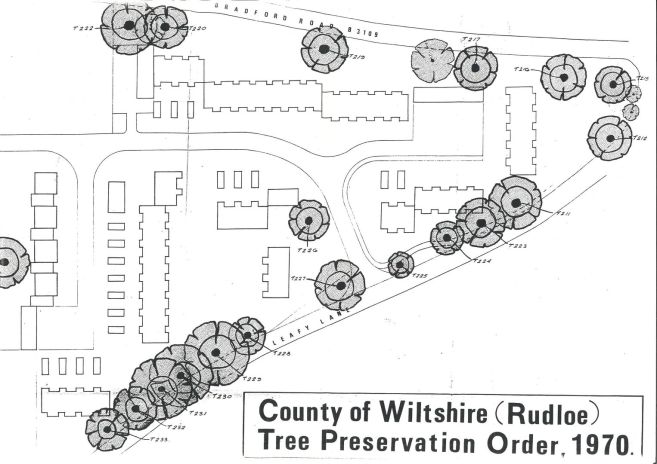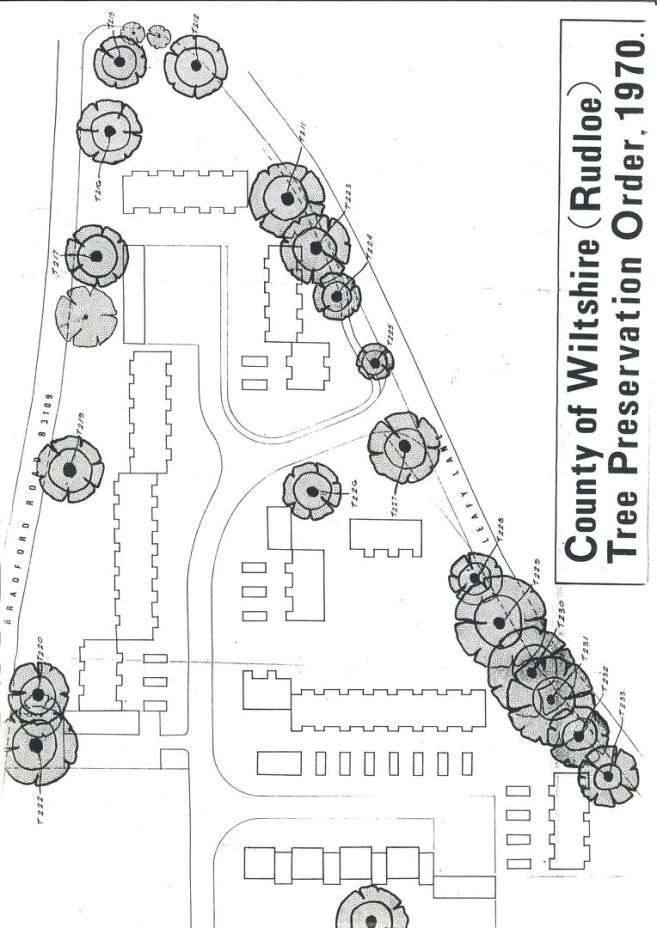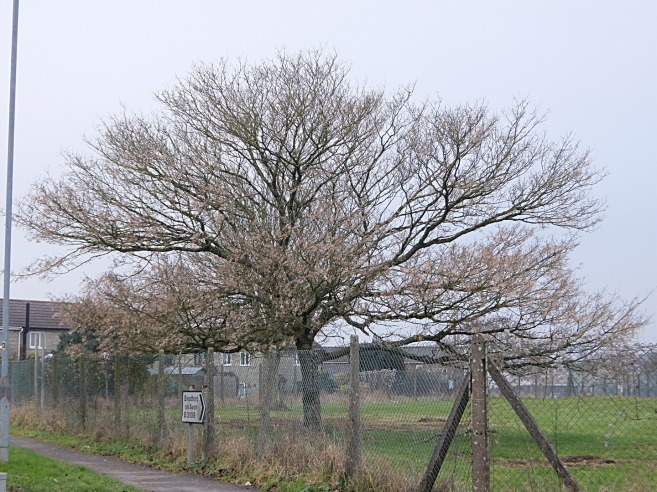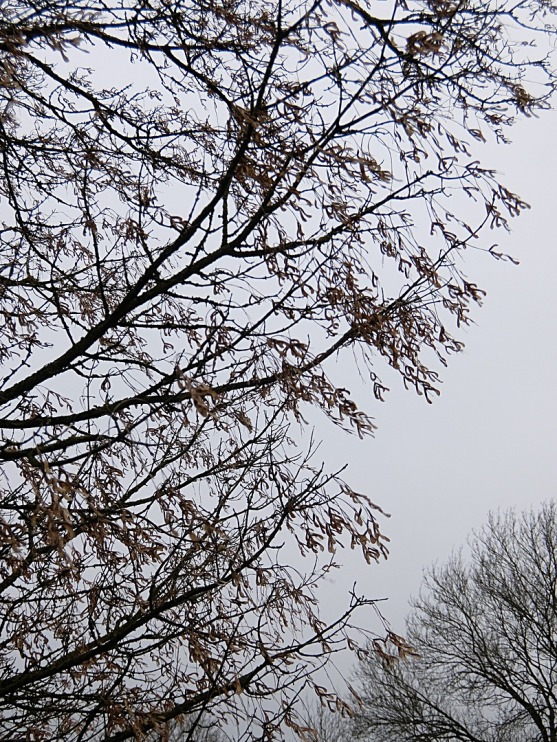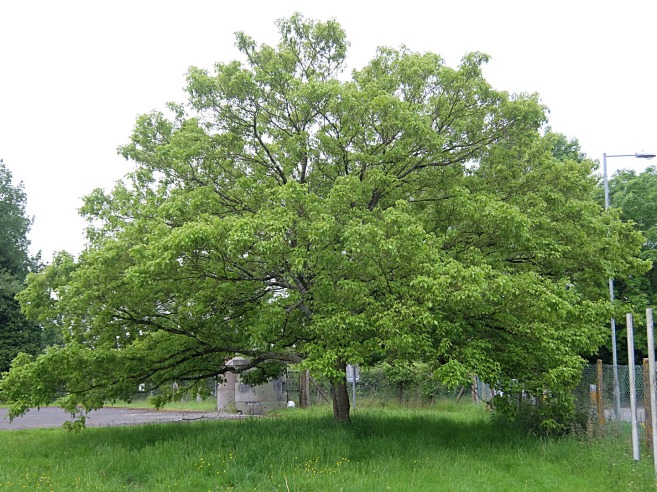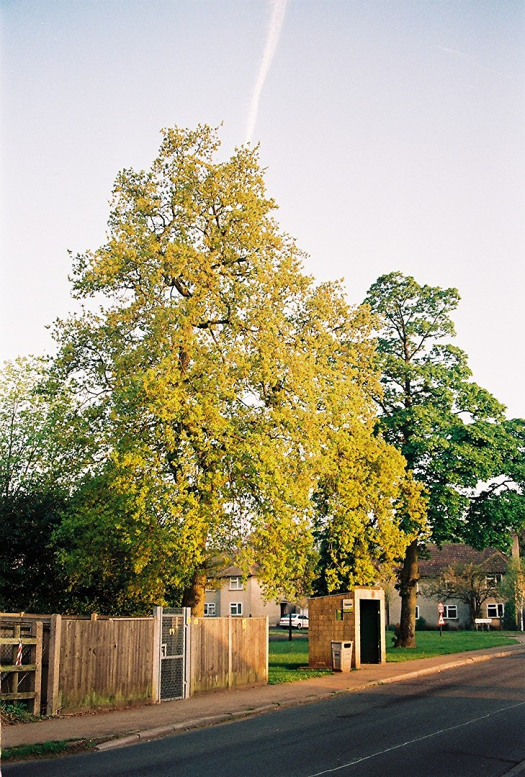Welcome to the Rudloe and environs website.
Here you will find news, articles and photos of an area that straddles the Cotswold Area of Outstanding Natural Beauty in north-west Wiltshire.
Contributions in the form of articles or photos are welcome. Even those with completely contrary views to mine!
Thanks to the website builder 1&1 and Rob Brown for the original idea.
Rudloescene now, in January 2014, has a sister, academic rather than anarchic, website about Box history here: http://www.boxpeopleandplaces.co.uk/
It contains thoroughly professional, well-researched articles about Box and its people.
Contact rudloescene through the 'Contact' page.

1995 Tree Preservation Order for woodland and individual trees in Leafy Lane Playing Fields (see February 2015 article below)
11th May 2024 - wild garlic and spring colour in Leafy Lane Wood
10th June 2021 - the wonder of Leafy Lane Wood remains, seventy years on from Bruce Armstrong's wanderings (Bruce lived at the Rudloe Park Hotel in the 50s) when he described the wood as 'a magical place' - see Bruce Armstrong's memories.
15th February 2021 - where have all the flowers gone, long time passing etc. Some twenty-five years ago, at this time of year, Leafy Lane Wood was replete with winter aconites in the part of the woodland across from Rudloe House. The following pictures show that, over this period, the aconites have, essentially, disappeared.
The woodland floor is now carpeted with ivy - this may be the reason for the disappearence of the aconites. Let's ask a local expert from the Woodland Trust for her opinion (Sarah, over to you ...). The following photographs show the only two patches of aconites remaining, one patch is within that great swathe we see in the 1990s picture, the other is further along Leafy Lane close to the entrance to right of way BOX107C.
28th May 2019 and the nationally scarce Bath asparagus in Leafy Lane Wood has emerged but is not yet in flower. Apparently, its name comes from the fact that it was once abundant around the city but now, due to its scarcity, it is protected under the Wildlife and Countryside Act (1981). The following photos include some of the Bath asparagus taken on our late-May bank holiday Monday, 27th May. Our public holidays have lost much of their history and mystique due to general national secularisation and normalisation of names. Even for a devout atheist, Whitsun and Whitsuntide evoke memories of Warrington's Walking Days (see Warrington Walking Day) and Silcock's funfair. Back to the Bath asparagus which the reader will, no doubt, find difficult to spot as it's a rod of green in a sea of green. 8th August 2019 update ... Viki Hess counted 79 Bath asparagus 'spikes' in the wood on 6th June 2019 - Viki's (three) photos have been added at the foot of the gallery below (they're the good photos - much better than mine!)
29th April 2019 - the consultation by Aaron & Jonathon Bewley Funeral Directors on the proposed use of land at Leafy Lane Wood as a natural burial ground (see 26th April article) has brought to light academic/ecological studies of the wood, one of which was previously unknown to me. The first (and previously unknown) is Leafy Lane Wood Management Project, a 2006 research project for an HND in Countryside Management at Lackham College, by Box resident Fran Brooks. The second is a 1998 Woodland Management Plan, commissioned by Leafy Lane Playing Fields Ltd (LLPF), by Messrs Greenman of Bath.
While much anecdotal information (and many photographs) may be found on Leafy Lane Wood and its environs in many articles on rudloescene with contributions from Jean Wooster, Gwen Davies and Marj Harvey, Jill Cook and yours truly, the 2006 project by Fran Brooks is (was!) the first piece of academic research on the state and status (with regard to the community) of the wood.
It's unfortunate that the existence of Fran's paper was unknown to many/most of the Rudloe community. It would, as she herself suggests, have been very useful in the community's 2015 bid, to Wiltshire Council, to have the wood declared an asset of community value. As it was, the bid was summarily rejected without any research being undertaken by Wiltshire Council - the landowner's (LLPF) ludicrous (see files in the 26th July 2015 article here 26th July 2015 article towards the foot of the webpage) representation being taken at face value.
The two studies may be found in the files below. It is again unfortunate that no follow-up action on either study was undertaken - the value of the wood as a community asset having been completely disregarded (in fact derided and treated with contempt) by LLPF's representations (again see files in the 26th July 2015 article here 26th July 2015 article). Fran Brook's study would have provided a sound, academic basis for the bid.
Adobe Acrobat document [10.7 MB]
Adobe Acrobat document [898.8 KB]
Note that the documents may not be reproduced, in full or in part, without permission. In fact, this statement also obtains on all the content of the rudloescene website (see the copyright logo at the foot of each webpage).
25th April 2019 - the 1970 Tree Preservation Order for the Springfield Close estate has been dug out of the archives and is shown below (twice - the tree numbers are a bit clearer on the 'portrait' version):
The trees illustrated are as follows:
Elm - T211 in the garden of 14 Springfield Close; T212, T215 and T216 in the triangle of land behind nos 16-22 Springfield Close; T219 on the Bradford Road verge behind 32/34 Springfield Close; T220 and T222 on the Bradford Road verge behind 52 Springfield Close and the garage block; T225 and T227 on either side of the entrance to Springfield Close All these elms have now gone of course and, at present, I have been unable to locate any photographs (but watch this space) apart from the photo below, taken in winter 1976/77, which shows the elm on the north side of the entrance.
Larch - T213 and T214 which are not labelled on the map but are the two smaller trees between T212 and T215
Ash - T217 on the Bradford Road verge behind the garden of 24 Springfield Close; T224 on Leafy Lane in the garden of 8 Springfield Close - this tree, which has just been pollarded, is the subject of a separate article below; T228 on the Leafy Lane verge close to 1 Springfield Close
Horse Chestnut - T218, not labelled on the map (as it had probably already gone), but was presumably the tree adjacent to T217 (ash) on the Bradford Road verge behind the garden of 24 Springfield Close; T221, not shown on the map but this is presumably the tree which still stands behind 56 Springfield Close; T232, still standing, in the garden of 13 Clift Close; T234, also a horse chestnut perhaps in a Clift Close garden, is not labelled on the map.
Beech - T226 in the garden of 5 Springfield Close was felled, illegally, by the owner in the 80s; T229, T230 and T231 were felled, with permission, in 1994.
Sycamore - T223 still stands on Leafy Lane in the garden of 12 Springfield Close; T233 still stands in the garden of 13 Clift Close.
So, all nine elms have gone, the two larch have gone, two of the three ash have gone and one has recently been pollarded, two (and perhaps a third?) of the four horse chestnuts still stand, both sycamores still stand and all four beeches have gone. Of the twenty-four trees with TPOs in the Springfield Close area, eighteen have disappeared.
April 2019 and another of Leafy Lane's mature trees is laid low ... but perhaps not. Pollarding is one of the techniques for ensuring longevity (the other is coppicing). According to Oliver Rackham, 'An ash tree usually falls to pieces and disappears at about 200 years. If periodically cut down (coppiced or pollarded) it regrows indefinitely and will often live to 400 or more' (The Ash Tree, 2014, p24). Locally, we see pollarded willow, hazel, lime, even horse chestnut but I cannot recall any pollarded ash - this one, if it does pollard (see below), will be a local first. This is the ash at the southern end of Leafy Lane, shown below last summer (at left) and now at right and below.
The ash, according to the tree fellers (but there were only two of them?), was/is suffering from ash dieback with twigs showing, apparent, distinctive yellowing. The remaining trunk has a number of new(ish) shoots emanating from the severed branches. Daniel (of Tree Parts, Ashley) predicted that these shoots will wither because of the dieback. But nil desperandum, if they don't and the tree continues to sprout, it will outlive us all (see 22nd July 2019 below).
In Rudloe (or Radlow as it is known locally), at this time of year, one will orfen see locals retiring to the terrace for a Pimms (there used to be a selection of seven but now just one) before sapper. In keeping with such castom, each day Daniel and Sam brought a lanch hamper; on the day of the picture the sandwiches were of the rather prosaic pastrami but last week they partook of gravadlax (salmon to you) and dill.
With regard to ash and pollarding, there is a photo of a 'copse' of pollarded ashes on page 100 of The Ash Tree (Rackham). Another interesting book on ash is The Ash and The Beech by Richard Mabey (2013 in Vintage paperback).
May 2017 and another miracle unfolds at Rudloe Fiveways. The images below are of the tree at the top of Westwells Road, inside the ex-RAF Rudloe Manor No. 2 site (not exactly Leafy Lane I admit but close enough).
The tree is unusual and remains to be identified but initial research suggests that it is a 'single-leaved ash' (however, the winged seeds of this tree don't quite fit with illustrations of the single-leaved ash's seeds).
29th October 2016 - The Miracle of Leafy Lane. For unfathomable reasons, I have walked past the tree opposite the entrance to Springfield Close (in the Wessex Water compound) hundreds of times without taking too much notice of it. However, I do believe it is an elm and as only a few elms survive around the country, this could be the Miracle of Leafy Lane (if I am right). Familiarity breeds contempt maybe.
Elm leaves are quite distinctive, with serrated edges and pointed ends - the photo below shows leaves on the Leafy Lane tree:
4th October 2015 - another mature tree felled in Leafy Lane
A mature Leafy Lane ash, beyond the telephone pole at left of picture was felled in late September 2015. It would be beneficial for the local community to know who authorises tree fellings and why. The purpose of and responsibility for the felling of the sycamore adjacent to the Portal Avenue bus stop remains a mystery (see article 'The mystery of the disappearing tree below') in spite of a number of enquiries to the local council and Wiltshire Council.
It will be interesting to see if the ash coppices but it isn't likely as the felling has taken place at the wrong time of year. If an ash tree is felled in late winter or early spring the stump will stay dormant all through that year and only sprout coppice the following year. It will appear dead, but it isn't!
Certainly the purpose of the sycamore felling appears to have been to have a bare stump where once a tree stood as all sprouting coppice was continuously removed. As indicated above, the local community should be aware of the perpetrators of and rationale for such environmental abuse.
Eventually, Leafy Lane will be renamed Tarmac Lane.
29th June 2015 - Bath asparagus in flower in Leafy Lane Wood
4th June 2015 - Gill Cook has provided some enlightenment (to me) regarding three plants, not mentioned in Mrs Wooster's lists, which are growing in Leafy Lane Wood. These are Star of Bethlehem, Bath asparagus and sanicle. Star of Bethlehem belongs to the same family as Bath asparagus (which is also known as wild asparagus, spiked Star of Bethlehem, Prussian asparagus, ...). Bath asparagus has, apparently, become quite rare owing to loss of habitat; however it appears to be thriving (relatively) in Leafy Lane Wood. The sanicle in the photo has almost 'gone over'; the flowers, at their peak, are in the form of small umbels (look it up!). In times gone by, sanicle was widely used as a vulnerary (look that up too!). Photos follow - more photos of flora in Leafy Lane Wood can be found in the various galleries here: http://www.rudloescene.co.uk/localities/rudloe/
February 2015. A rudloescene reader has asked for the Tree Preservation Order information for Leafy Lane Playing Fields to be published as most local people are unaware of it. The files below show the order itself dated 1995 (also shown in the title picture above) and the two schedules, one for the woodland and the other for individual trees (note that 2 No. poplars in line G1 are misidentified - they are whitebeams)..
The requirement to publish has come about as Leafy Lane Playing Fields Ltd in early February 2015, has been removing scrub in the line of trees labelled G1 on the TPO. Unfortunately, during this removal work six of the hawthorns in the 'individual tree' schedule have, effectively, also been removed. Locals who were involved in the setting up of the TPO through the Rudloe Action Group (RAG) in 1995 were now (in 2015) bound to involve Wilts County Council (the enforcement organisation) in order to try to put a halt to the removals.
Contact details for the Wilts CC officer responsible are as follows:
email: David.Wyatt@wiltshire.gov.uk
phone: 0300 4560100 ext. 16762
Another useful contact is/are 'Wiltshire tree wardens' here: http://www.wiltshiretreewardens.co.uk/contact.html
JPG image [147.5 KB]
JPG image [60.8 KB]
JPG image [73.2 KB]
The mystery of the disappearing tree
Over the autumn/winter/spring 2012/13, this sycamore in Leafy Lane (perhaps eventually to be renamed Tarmac Lane) has been cut down and the growth from its stump treated with herbicide. It's still struggling to survive though. I have made enquiries with Wilts CC over many months about who may be responsible for the tree and its demise but, unfortunately, have drawn a blank. My next port-of-call will probably be Defence Estates (as the tree is at the entrance to Park Lane).
As you may see, it made a fine sight but this area is now a piece of bare verge with stump. Whilst sycamores can be regarded as 'weed' trees because they propogate quite readily (although, given the number of ash saplings in our garden, I would say that this is more true of ash), they are, I believe, very attractive, particularly the bark (ref Richard Inchbold's painting 'In Early Spring' shown on page 267 of Richard Mabey's Flora Brittanica).
So, who cut down this tree and why? Please make contact if you have any information.
Mrs Wooster's flora and fauna lists
Mrs Wooster, who lived at Rudloe House in Leafy Lane, was very interested in wildlife. She produced lists between 1982 and 1994 of the flora and fauna seen in Leafy Lane Wood and elsewhere; the lists are shown below. I have been presumptious enough to produce a 2010 update of her lists, shown at the end.
Microsoft Word document [105.1 KB]
Microsoft Word document [69.3 KB]
Microsoft Word document [50.8 KB]
Microsoft Word document [58.8 KB]
Microsoft Word document [52.4 KB]
Microsoft Word document [14.2 KB]
Carnage in Leafy Lane
Mrs Wooster would be distraught at the carnage of Leafy Lane flora. The beeches, shown below, were the subject of tree preservation orders (TPOs); there were many trees on the east side of Leafy Lane with TPOs, now there are just a handful.
The limes, I believe, were considered a litigation risk by shedding leaves into the road! Leaves! Off with their heads!
The most criminal act though was the felling of a magnificent ash (also with TPO) at the entrance to Kidston Way. As usual, if asked to investigate the health of a tree, a tree surgeon will find problems. Find me a tree without problems! Nice work if you can get it.






















































